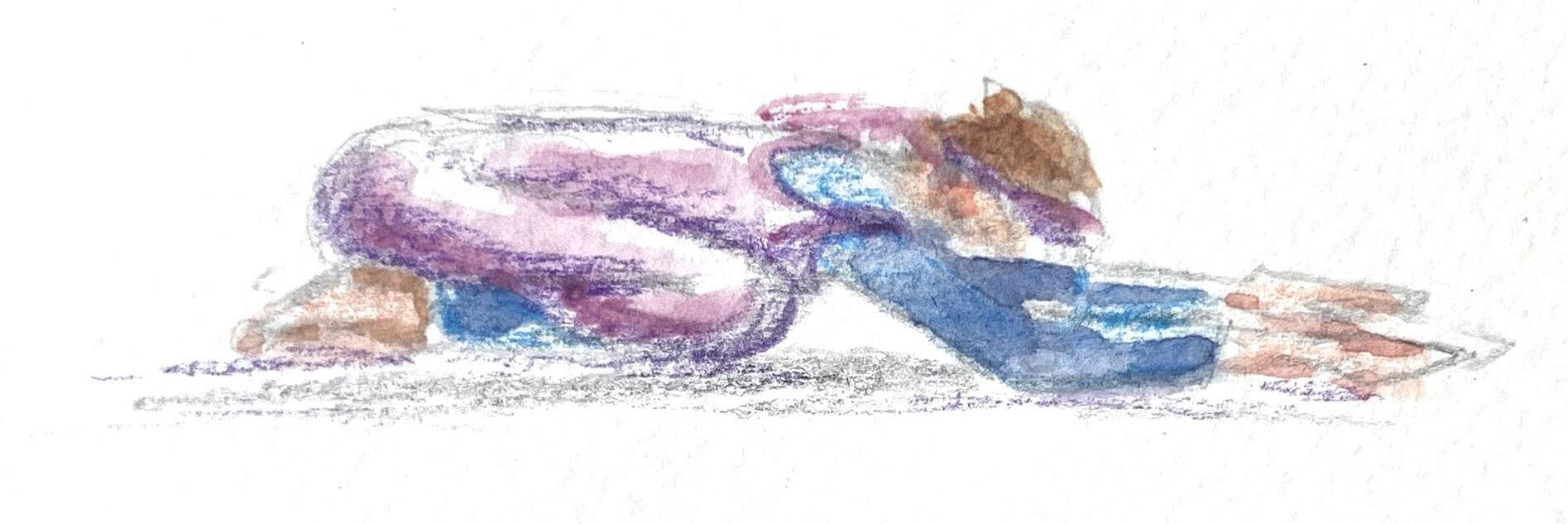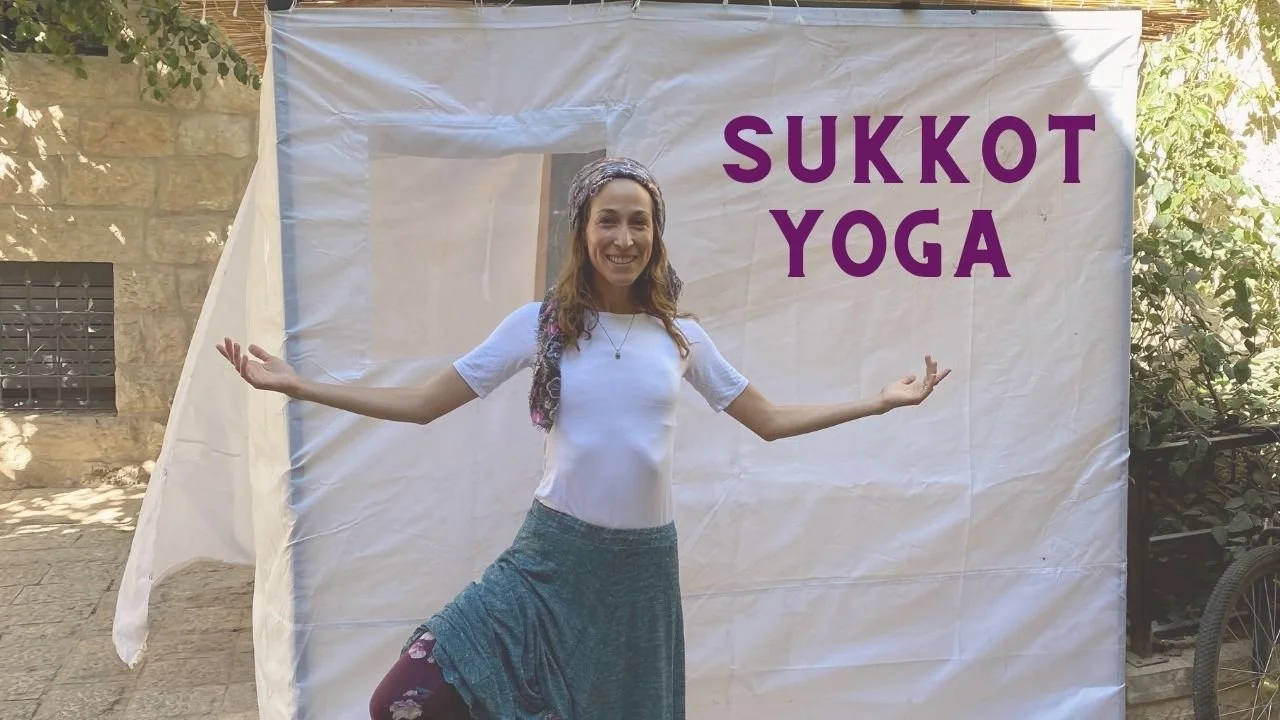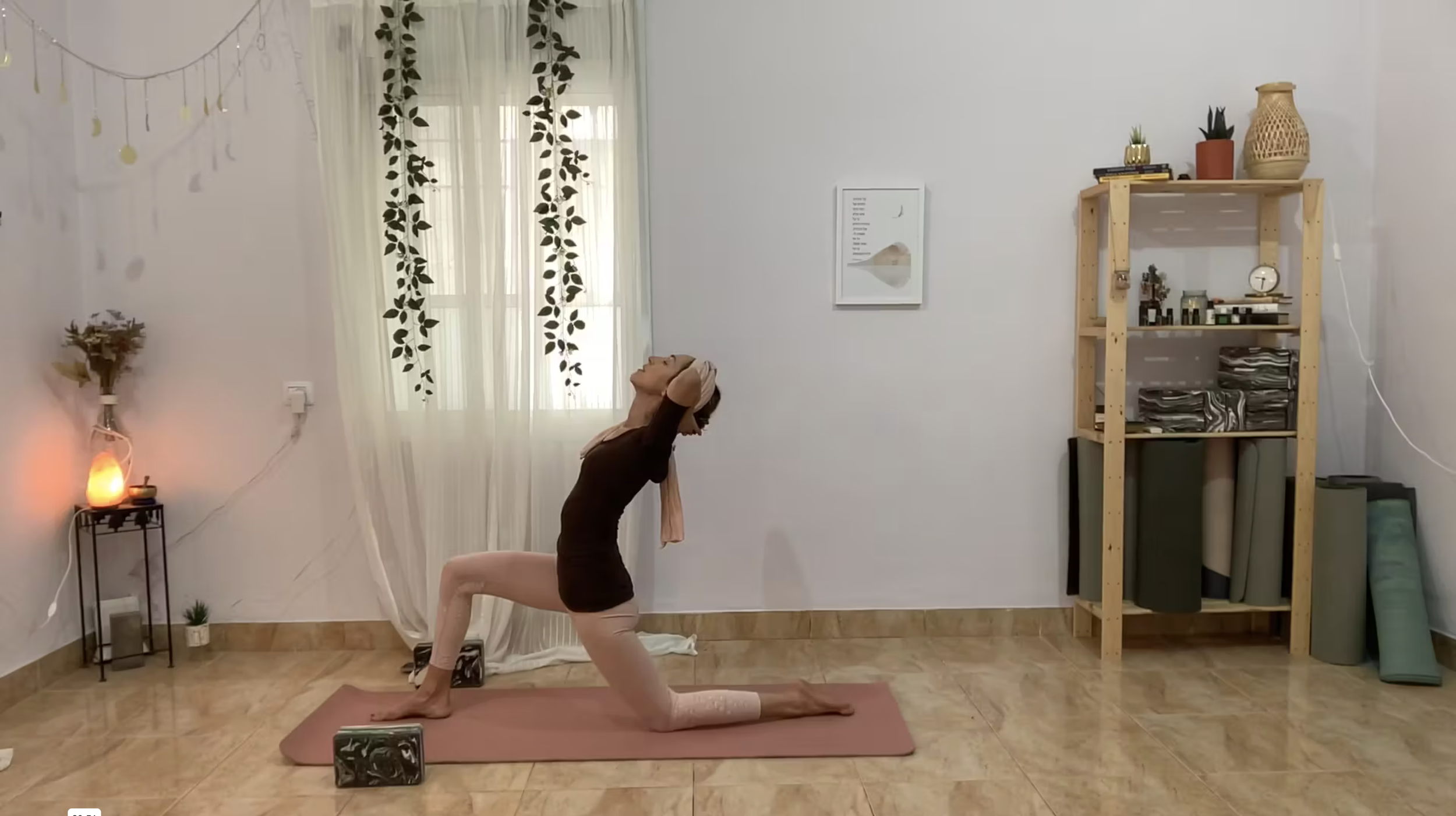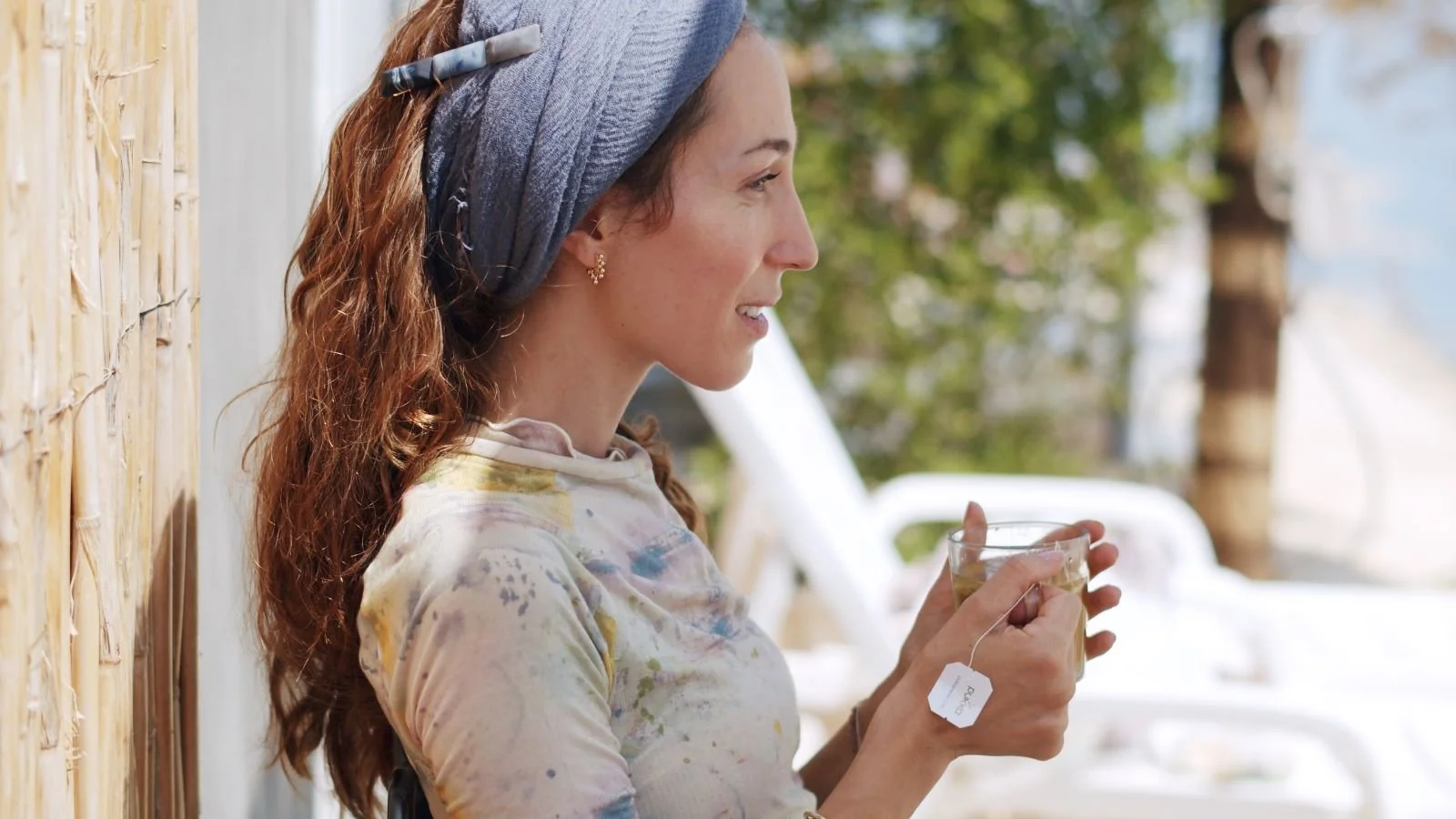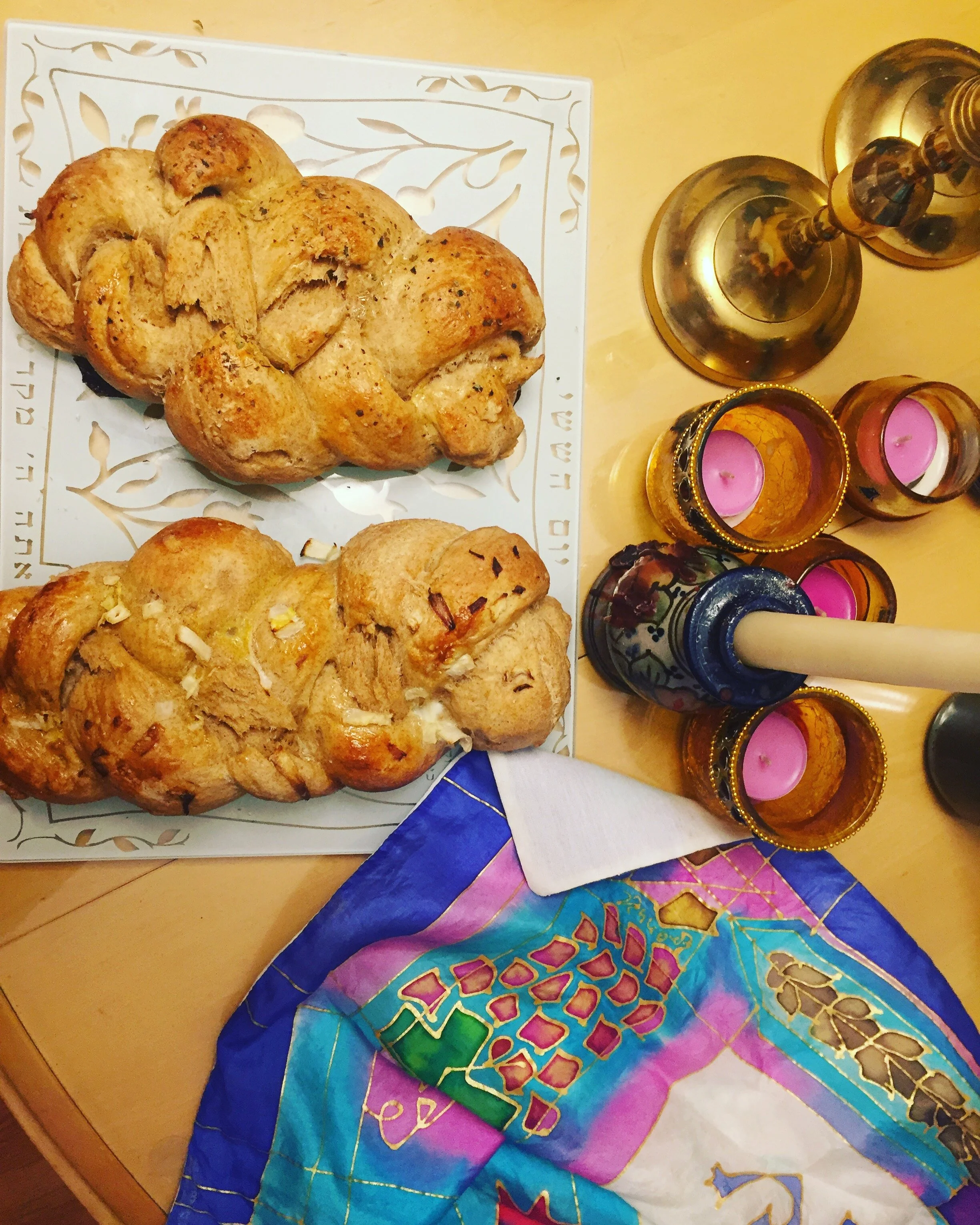Jewish Yoga and Meditations for Elul
Jewish Yoga and Meditation for Elul
Created by Jenna Zadaka, breathandsoul.net. To download and print this manual as a PDF, press here.
We will be exploring the month of Elul and highlighting three themes that can be used during your yoga or mindful practice. This manual will provide you with Torah & Somatic Wisdom to enhance your connection with your mind, body, and breath in relation to the inner teachings of this month. Torah teachings inspired by the writings of Rav Dovber Pinson in his book, The Month of Elul, The Rebbe Rashab in Kuntres HaAvodah, the Lubavitcher Rebbe, Rebbe Nachman, and Rav Kook. Painting above by Sheva Chaya.
THEME 1: Heart Openers: OPENING THE HEART SPACE
THEME 2: Child’s pose: RETURNING TO OUR SPARK OF GOODNESS
THEME 3: Savasana: THE GREAT EXHALE AND MINDFUL TRANSITIONS
Theme 1: Opening the Heart
“We must continually ask ourselves; what allows us to expand the joy in our heart? Rabbi Nachman quotes, “The main place of joy is in the heart””
Ani L’ Dodi V’dodi Li / I am to my Beloved and my Beloved is to me
The month of Elul is about entering the depth and wisdom of the heart space.The letters of the word Elul are an acronym for a verse in Shir Hashirim (Song of Songs by King Solomon), “Ani L’dodi V’dodi Li” meaning, “I am to my Beloved and my Beloved is to me”. This romantic metaphor articulates that our relationship with our creator is similar to that of two lovers. Judaism is a warm and intimate relationship with G-d, not a cold set of laws. There is an intense adoration between G-d and the Jewish people which comes to the surface during the month of Elul. The Chassidic masters teach that the high-holidays are phases in a loving relationship. Rosh Hashana is our engagement, Yom Kipur is our wedding, Sukkot is our after-party and Sheva Brochot. Our current phase of Elul is the courting and dating, a meeting between lovers.
Chassidus teaches that the verse “Ani L’dodi V’dodi Li” represents an ‘arousal from below’ to elicit an ‘arousal from above’. Elul is the “arousal from below”/ “Itaruta Diletata”. Traditionally this means that the Avodah (inner work) of the relationship must begin the people, below, until we arouse the love of G-d, above. Paralleling this with a yogaic view, an ‘arousal from below’ may refer to the stirring of the heart, which results in an influence and activation above, the mind. When we engage is soul searching during this month, we are reorienting our lives so that we can be consciously aware and open to the reality of our Creator. Entering a relationship fully necessitates leaving our mechanical thinking mind behind and and entering into the intuitive heart space. Allowing our hearts to open with compassion and make space for another, we leave our egos and reorient ourselves to the needs and feelings of another. The letters of Elul are also an acronym for, “Es L’vavcha, V’es L’vav..” This phrase comes from the famous prayer of the Shema, “Then hashem your G-d will open up your heart and the hearts of your [offspring]”. This verse alludes to the spiritual transformation through the opening of the heart.
The King is in the field, in love.
Rabbi Schneur Zalman (the Alter Rebbe, first Rebbe of the Chabad movement) uses the analogy that the “King is in the field”, referring to G-d’s closeness and approachability during this month of Elul. We are called upon to return to G-d, our King, with love. ““When you shall return to Hashem, your G‑d, with all your heart and all your soul.” Entering into this loving relationship requires us to pay attention to the hand of G-d in our lives and the miracles that the creator constantly performs for us. Rebbe Nachman of Breslov teaches that the phrase ‘paying attention’ in Hebrew is ‘tesumat lev’, which literally means, ‘attentiveness of the heart’. In order to pay attention to divine consciousness, our heart must be attentive. This is one reason we engage in prayer, known as the ‘avodat lev’, or ‘service of the heart’. In the words of the great Rav Avraham Isaac Kook in his book, The lights of Penitence, Lights of holiness, the moral principles, essays, letters, and poems, “The heart must be filled with love for all. The love of all creation comes first, then comes the love for all mankind…but the highest of all loves is the love of God, which is love in its fullest maturing (p.135).” The Pri Eitz Chayim teaches that during the month of Elul, the Thirteen Attributes of Divine Compassion are openly revealed. The value of 13 is the gematria of the word, “Ahavah”/”Love”. During Elul, there is love in the air. It is the type of love that comes from a mother who lovingly desires for her unborn child that is still in formation (Pinson, p. 76).
Elul Yoga Posture: Heart Openers
We must continually ask ourselves; what allows us to expand the joy in our heart? Rabbi Nachman quotes, “The main place of joy is in the heart” (Likutey Moharan 1, 24:2). He teaches that one cannot attain Yishuv haDaat (mental calm and serenity), until one first attains a joyous state. The power of joy can open us to divine love. The root of all love comes from the Divine attribute of Chesed (lovingkindness). King Solomon understood this all-consuming power of love when he recited, “Many waters cannot extinguish love”(Songs 8:7). Part of leaning into emotional harmony is accepting disappointments in our relationships. When we can open the heart center and accept the disillusionments, we are able to learn and mature from our perceived failures. When we experience disappointments in our relationships with others and G-d, instead of shutting down, how can they help us mature, soften our hearts, and open us up to compassion?
“When we experience disappointments in our relationships with others and G-d, instead of shutting down, how can they help us mature, soften our hearts, and open us up to compassion?”
Enter into a heart opening pose such as camel, sphinx, wheel, melting heart, or any of your choosing (click here to view pictures of heart opening poses). When you feel supported in the pose, turn your attention to your heart space and ask yourself, ‘Is there fear? Is there hope? Is there love? Is there heaviness?’ Practice slow, expansive breathing. Visualize your breath as a color of light. Breathe in that color and circle the breath around the front of the heart, the sides of the heart, and the back of the heart. Invite spaciousness and compassion into the heart space with every breath of light.
Theme 2: Returning to our spark of goodness
The Letter Yud: Our spark of goodness
“The Yud within us is the spark of humble goodness (the Nekudas haTov) that remains pure despite anything.”
According to Jewish mysticism brought down by Isaac Luria Ashkenazi, also known as the ‘ARIZal’, each month has a Hebrew letter that is deeply connected with the energy drawn into the world. Each letter from the Lashon haKodesh (holy tongue) is a host for metaphysical energies. The letter connected with Elul is the ‘Yud’, the smallest letter of the Aleph-Beis. The ‘Yud’ is the point of origin of all the other letters. It represents both the origin and essence of each letter, and its pure potential. The ‘Yud’ within us is the spark of humble goodness (the Nekudas haTov) that remains pure despite anything. No matter how “defiled” we get or how far we stray from our essence, this spark remains untouchable. This is similar to the cruse of oil in the story of Chanukah which remained pure despite the chaos and destruction all around. The ‘Yud’ is also related to the level of the soul known as the “Yechidah”, or the “Single Unity”. The Rebbe Rashab (the 5th Rebbe in the Chabad movement), in his sefer Kuntres Ha’avoda (Essay on the Service of the Heart), teaches that the experience of the Yechidah is one of unity consciousness. It is the part of the soul that is always united with the One Above.
The month of Elul encourages us to find the YUD, the spark of goodness and wisdom within all of our experiences over the past year. Every event has a point of wisdom, and it is our work to find the inner teaching of each experience, no matter how negative it may have been perceived to us. No matter what happened in the past year, we can always return to our inner ‘Yud’, our origin and infinite potential.
The Zodiac- The Virgin (Besulah)
Jewish mysticism teaches that the patterns of the 88 constellations have a positive or negative affect on one’s life depending on how we channel the energy. However, although the Zodiac has an influence over us, we always have the power to choose to rise above our circumstances. The zodiac is a took that helps us actualize our highest potentials. The Zodiac for Elul is the Besulah, the virgin. Similar to the letter ‘Yud’, this represents our purest essence which remains untouched no matter what. The Lubavitcher Rebbe (Rabbi Menachem Mendel Schneerson) teaches that when we are called upon to perform Teshuva during Elul, it is not something outside of ourselves, but it is returning to who we really are. The word Teshuva comes from the word “Shuv”, to return.
Elul Yoga Posture: Child’s Pose
“The letters that make up the word “tikkun” (rectification) can be reorganized to spell the Hebrew word “tinok” , which translates to ‘child’. This is a hint that our soul tikkun is to reconnect with this inner child state of wonder and awareness of every moment.”
To embody the inner goodness within us and connect to our purest self which is never defiled, we enter into child’s pose. This pose turns our gaze and attention inwards. Open the knees wide and press your forehead onto the mat, extending your arms straight in front of you, palms facing the ground. Child’s pose reminds us to live from a place of wonder, like a child. The letters that make up the word “tikkun” (rectification) can be reorganized to spell the Hebrew word “tinok” , which translates to ‘child’. This is a hint that our soul tikkun is to reconnect with this inner child state of wonder and awareness of every moment. The inner ‘Yud’ during our yoga practice is also the breath, our constant source of awareness and presence. Throughout your yoga practice, if your mind starts to wander or you are struggling with a pose, return to the ease of your breath. Our breath is a reminder to return back inwards, back to our essence.
Theme 3: The Great Exhale and Mindful Transitions
“During Elul, we direct ourselves to bring more attentiveness to the exhale, specifically the last moment of the exhalation.By bringing awareness to the subtle pause at the end of the exhale, we are bringing full, intentional completeness to every breath-cycle. ”
G-d creates beginnings, but we create the endings
Elul is considered the ‘Acharis Shana’, the “end of the year”. Ending projects can be more challenging than beginning them. Cooking a meal is more enjoyable than cleaning up. New opportunities are often accompanied by feelings of exhilaration and vitality; however the commitment and excitement often fade. New, exciting possibilities are gifts from above. In the words of Reb Leibele, “Bereishis Bara Elokim” means, “G-d creates beginnings, but we create the endings.” The gifts of passion, strength, and inspiration we receive when embarking on something new, such as the beginning of a spiritual path, are gifts from above. It is us who take responsibility to utilize those ‘gifts from above’ into a completed project. The inner work of the month of Elul is to ensure good endings. We are called to finish the year with consciousness and remain present as we encounter endings throughout our life. In the words of Rav Pinson, “Just as there is an art or sensitivity to how one enters a home, there is an art to how one leaves it.”
Intentional Elul Exhale
During breathwork, we often give heightened focus to the inhale. It’s more exhilarating; there is the widening breath that fills up the belly and brings us new energy and vigor. During Elul, we direct ourselves to bring more attentiveness to the exhale, specifically the last moment of the exhalation.
By bringing awareness to the subtle pause at the end of the exhale, we are bringing full, intentional completeness to every breath-cycle. This exhalation is neurologically connected to the relaxation response. The exhale, similar to a sigh, is particularly important as we finish a task. With each exhale, allow yourself to let go. Let anything stuck or heavy be released. A shallow exhale can result in excess carbon dioxide to remain in your lungs, which leads to quicker and shallower inhalations. Let us utilize the energy of Elul to commit to lengthening our exhale and focusing on the momentary pause at the end of our out-breath.
The same idea of ‘Acharis Shana’ applies to exiting a yogaic posture mindfully. We often enter into a pose with grace and elegance, much less so with the exit. We focus on moving from pose to pose without paying much attention to the transitions. We tend to do this because the actual yoga poses are glamorous - the transitions are not rewarding for the ego. Whereas a pose feels stable, secure, and well-aligned, transitions require subtle movements and balance as you shift your weight strategically. The work of Elul is to stay present during the transitions, as well, paying deep attention to the mind, body, and breath as you mindfully step out of a posture.
Elul Yoga Posture: Savasana
Elul is a beckoning to complete our year, projects, and tasks with intentionality, self-reflection, and compassion. This final reflection and integration is built into every yoga sequence, known as “Savasana”, or “final resting posture”. Give yourself ample time for this ending posture throughout the month of Elul. This posture can be a passive relaxing pose, or it can be a transformative mindful practice. Elul is anything but a passive month; it requires deep, internal work. There is a spiritual practice in Elul of ‘Cheshbon HaNefesh’, or “accounting of the soul”. Elul is a time to review each month in the previous year and reflect on how we have been living. (For an in-depth guide of this practice, read Practice 2: Reviewing and Refining the Entire Past Year in Rav Pinson’s book, The Month of Elul) Final Savasana in Elul will utilize this same reflective practice.
If you are a yoga practitioner, guide your students to walk through the entire sequence they just completed in their mind’s eye, thinking through each posture or vinyasa they performed. Ask them to notice the effects on the body, the energetic imprint from each pose. Let the subtle energy shifts integrate into the body, capturing the somatic wisdom and physical benefit of each posture. Allow your students to go through the practice on their own or verbally guide them through the sequences that they performed. Even once we exit out of our Savasana pose, we continue to stay present as we close our yoga practice, such as rolling up our mat intentionally and taking our first mindful steps into the next part of our day. Staying present as we encounter endings will allow us to gather all of the experiences from the previous year, whether we perceived them as good or bad, and integrate the wisdom and blessings onto our next chapter.
Enjoyed this article? Consider booking Jenna for an Elul zoom yoga class, or a Jewish learning workshop!
Want more? Read 3-part meditation for Rosh Hashana






